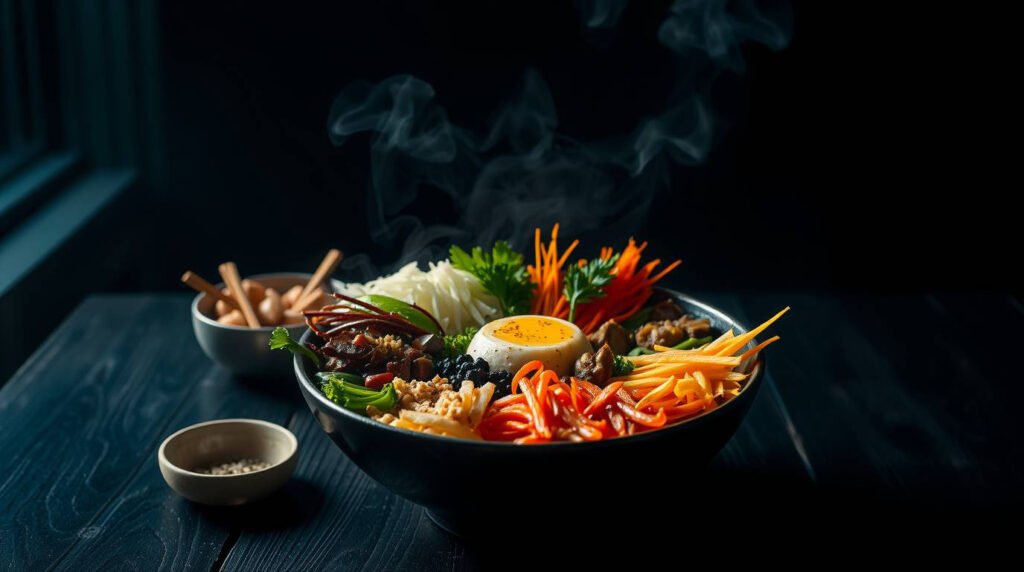Bibimbap is a vibrant and harmonious dish that beautifully combines a variety of sautéed vegetables, marinated tofu, and a perfectly cooked grain, all topped with a luscious sauce and often a sunny-side-up egg. This Korean-inspired vegan version takes the traditional elements of bibimbap and transforms them into a colorful, plant-based masterpiece that is as nourishing as it is satisfying. Each bite offers a delightful explosion of flavors, textures, and colors, making it not just a meal but an experience that warms the heart and lifts the spirit.
Tarot, Chakra & Magick Insights:
Tarot Card: Temperance – Harmony, balance, and integration of flavors.
Chakra Focus: Solar Plexus – Empowerment through bright veggies like carrots and fermented gochujang, supporting digestion and confidence.
Magical Element: Fire & Earth – The fiery spice of the sauce meets the grounding rice and vegetables. A perfect spell for integration and inner alignment.
The Origins of Bibimbap
Bibimbap has a rich and storied history that dates back to the Joseon Dynasty in Korea (1392-1910). This dish was originally a way to use up leftover vegetables and rice, showcasing the Korean philosophy of 'banchan,' which emphasizes balance and variety in meals. Traditionally, bibimbap was served in a stone bowl known as 'dolsot,' which retains heat and creates a crispy layer of rice at the bottom, adding a delightful crunch to the dish. The word 'bibimbap' itself translates to 'mixed rice,' reflecting the dish’s core element of combining various ingredients into a single, harmonious bowl.
Over the years, bibimbap has evolved into a beloved staple not only in Korea but worldwide, celebrated for its versatility and ability to adapt to different tastes and dietary preferences. In this vegan rendition, we honor the traditional roots while embracing plant-based ingredients that burst with flavor and color.
Unique Ingredients and Flavors
What truly sets this vegan bibimbap apart is its array of fresh, seasonal vegetables and the vibrant flavors they bring. Imagine a bowl filled with beautifully prepared ingredients: sautéed spinach, crunchy carrots, earthy mushrooms, and crisp cucumber, each adding its own unique taste and texture. The magic lies in the careful preparation of these vegetables—each one is treated with love, often lightly seasoned or marinated, allowing their natural flavors to shine through without overpowering one another.
At the heart of this dish is the marinated tofu, which serves as a protein-packed base and sponge for the dish's accompanying flavors. Marinating the tofu in a blend of soy sauce, sesame oil, and a hint of garlic infuses it with a depth that complements the freshness of the vegetables. The secret here is to let the tofu soak in the marinade for at least 30 minutes, allowing it to absorb those rich flavors that elevate the entire dish.
And we cannot forget about the sauce—the bold and spicy gochujang sauce that brings everything together. Made from fermented chili paste, it adds a kick of heat and a touch of sweetness, making each bite a little explosion of flavor. A drizzle of this sauce on top of your assembled bibimbap transforms it from delicious to downright addictive.
Cooking Techniques and Presentation
The beauty of preparing vegan bibimbap lies in its simplicity and the opportunity to get creative. Each component can be prepared in advance, making it a perfect dish for meal prep or a festive gathering. The key is to cook each vegetable separately; this ensures that none of the flavors overpower one another and allows you to control the doneness and texture of each ingredient. Sautéing in a hot pan for just a few minutes ensures that vegetables retain their vibrant colors and nutrients while becoming tender yet still crisp.
Presentation is another vital aspect of bibimbap. The visual appeal of a well-constructed bowl is a feast for the eyes, inviting diners to dig in. Layering the ingredients artfully not only highlights the beautiful colors but also builds anticipation for the first bite. The final flourish—a sprinkle of sesame seeds or a scattering of fresh herbs—adds that finishing touch that makes the dish truly pop.
As you embark on making this Korean-inspired vegan bibimbap, remember that cooking is an art, and like any artist, you have the freedom to express yourself. Feel free to personalize your bibimbap with different vegetables or grains, and don’t hesitate to make it your own. The spirit of bibimbap lies in its adaptability and the joy it brings, making it a dish worth sharing and celebrating with friends and family.



 Thinly slice 1 carrot, 1 zucchini, and 1 cup of shiitake mushrooms. In a large skillet, heat 1 tablespoon of sesame oil over medium heat. Sauté the carrots for 3-4 minutes, then add the zucchini and mushrooms. Cook until tender, about 5-7 more minutes.
Thinly slice 1 carrot, 1 zucchini, and 1 cup of shiitake mushrooms. In a large skillet, heat 1 tablespoon of sesame oil over medium heat. Sauté the carrots for 3-4 minutes, then add the zucchini and mushrooms. Cook until tender, about 5-7 more minutes. Add 1 tablespoon of soy sauce and a sprinkle of salt to the vegetables and stir well to combine. Let cook for another minute to absorb the flavors.
Add 1 tablespoon of soy sauce and a sprinkle of salt to the vegetables and stir well to combine. Let cook for another minute to absorb the flavors. In a small bowl, mix together 2 tablespoons of gochujang, 1 tablespoon of maple syrup, 1 teaspoon of sesame oil, and 1 teaspoon of rice vinegar until smooth.
In a small bowl, mix together 2 tablespoons of gochujang, 1 tablespoon of maple syrup, 1 teaspoon of sesame oil, and 1 teaspoon of rice vinegar until smooth. In a large serving bowl, add a generous scoop of the cooked rice as your base. Arrange the sautéed vegetables on top of the rice in sections, creating a colorful rainbow effect. You can also add sliced cucumber and avocado for extra creaminess.
In a large serving bowl, add a generous scoop of the cooked rice as your base. Arrange the sautéed vegetables on top of the rice in sections, creating a colorful rainbow effect. You can also add sliced cucumber and avocado for extra creaminess. Top with a handful of fresh spinach, a sprinkle of sesame seeds, and a drizzle of the spicy sauce. For a protein boost, add a few slices of baked tofu or tempeh.
Top with a handful of fresh spinach, a sprinkle of sesame seeds, and a drizzle of the spicy sauce. For a protein boost, add a few slices of baked tofu or tempeh. Just before eating, mix everything together in the bowl, ensuring the spicy sauce coats all the ingredients. Serve immediately and enjoy the burst of flavors!
Just before eating, mix everything together in the bowl, ensuring the spicy sauce coats all the ingredients. Serve immediately and enjoy the burst of flavors!
